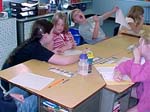|
We
completed 10 workshops on reading, writing and painting haiku at
the Harristown Elementary School, over a period of three weeks in
October, 2003. The workshops for grades 1-2 were one hour, and the
workshops for grades 3-5 were about one hour and fifteen minutes
each.
|
The
primary purpose of these workshops was to introduce students
to a visual thinking approach to writing, based on images
and associations from their own memories.
Haiku
is a poetry of perceptions, so it has a powerful impact on
the reader's memory. The natural result of reading haiku is
to remember similar situations and feelings (and, of course,
to write those memories down as new haiku or to create a painting
in response).
|
|
|
The
workshop began with students closing their eyes and imagining
the moment and related feelings of various haiku by famous
American and Japanese haiku writers. For example, what do
you imagine when you close your eyes to "see" this
well-known haiku by Colorado sheep farmer, James Tipton:
the
sun coming up . . .
five eggs
in the iron skillet
Images
appeal to the senses. What colors do you see in this haiku?
How did you know the skillet was black? What can you hear?
Can you taste the eggs cooking in the skillet? Is it cold
at dawn, and why do you feel the warmth of the stove or fire?
Where do you imagine you are when you see this sunrise and
hear those eggs cooking? What kind of day is this going to
be?
|
|
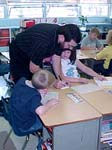
|
By
imagining and discussing several haiku, the students begin
to understand that if you use images in your writing, you
don't have to explain as much to the reader. The images contain
rich details such as colors, touch, smells and sounds.
The
second major realization from reading haiku is that each haiku
is about a single instant in time, and that each haiku is
written about a specific place. This is important because
each haiku must establish a mood or atmosphere, a feeling
that we associate with being in a certain place at a particular
time of the year. To write haiku, the students were asked
to imagine being at a specific location, then we gathered
up possible images that might be seen, heard, smelled, tasted
or felt at that location. We wrote haiku from these collected
images.
|
|
As
students began writing haiku, they wanted to know about the
form. What about the seventeen syllables? I ask them how many
syllables are in haiku, and one of them invariably gets it
right—there are two syllables in the word haiku. I stress
that haiku are usually made up of two fragments, two images
that are placed next to each other.
Haiku
are not sentences. They may not have a verb at all. They are
simply two images unified through a single instant in time
and a particular place. Sentences are too complete and leave
nothing for the imagination of the reader. Haiku are imagination
"jump starts" inviting you to complete the scene
that the writer begins. They only bring up a couple of things
and don't tell the whole story, never explain the feelings
involved, and leave it up to the reader to finish according
to the reader's own imagination.
|
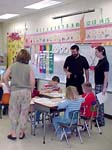
|
|
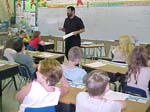
|
The
essential parameters of a haiku include: (1) the importance
of haiku as a means of stimulating memories and associations
in response to the images of the haiku (how to read a haiku
is the essential thing) followed by (2) an understanding of
how haiku are literary art made from images (images are words
that appeal to the senses) in a (3) form of two parts . . . one
image establishing the seasonal context or scene . . . pause . . . then
our reader's imagination gets a second image . . . which
invites the reader try to put the two together into a new
unified imagined whole. That's the joy of haiku.
|
|
The
natural response to a haiku is to write another haiku. After
reading and writing several haiku in collaboration as a class
and individually based on various imagined scenarios, students
were invited to complete two paintings.
|
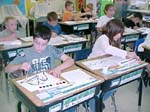
|
|
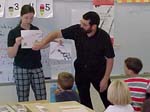
|
Millikin
honors student, Jennifer Griebel, shared her haiku
painting "River Fog" with the students.
She discussed the goals and techniques of Japanese sumi-e
paintings. Like haiku, sumi-e paintings only provide a minimal
number of images leaving things deliberately incomplete so
the viewer completes the scene in their own mind. She showed
the students how Japanese kanji are ideogrammatic, suggesting
images of things in words. She showed them the derivation
of mountain and river and gate in Japanese kanji, then she
encouraged the students to try a painting using only black
paint.
|
|
If
you use evocative images, the viewer will fill in the colors
themselves. She also encouraged the students to resist the
urge to fill the paper with paint, but to include only two
or three things in the painting. After completing a black
ink painting, the students were encouraged to use colors with
the same technique of including only two or three things and
not necessarily painting the entire objects.
|
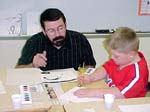
|
|
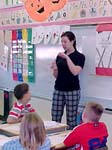
|
When
you effectively combine sumi-e and haiku, the goal is not
merely to illustrate the haiku, nor for the haiku to merely
provide commentary on the painting.
The
goal is for the two works of art to leap by associations and
to resonate with compatible feelings. Neither finishes or
completes the other. Both continue to ask the reader or the
viewer to continue to feel, to imagine, to live beyond the
moment being presented.
The
reader and viewer get to make the connections between the
two works of art.
|
|
The
workshops concluded with reading the haiku aloud and viewing
paintings by the students. And hopefully, of course, their
journey with poetry and painting continues on . . . a never-ending
life of moments worth painting or writing as haiku.
Still
dreaming up haiku,
—Dr.
Randy Brooks
Millikin University
|

|
|
